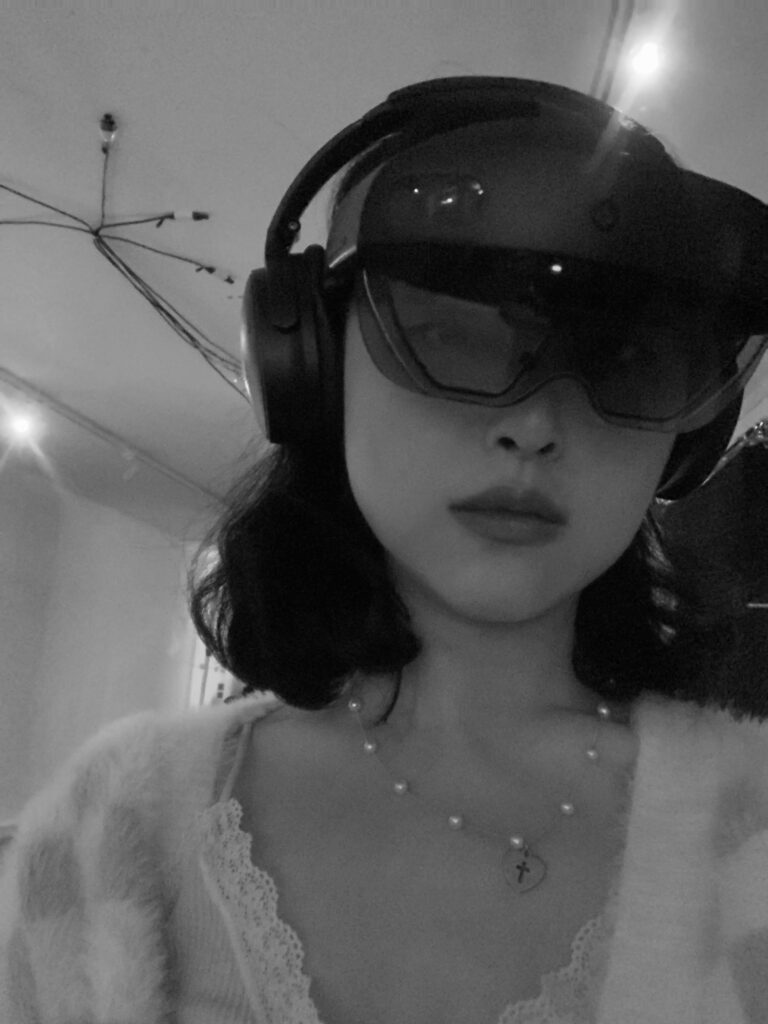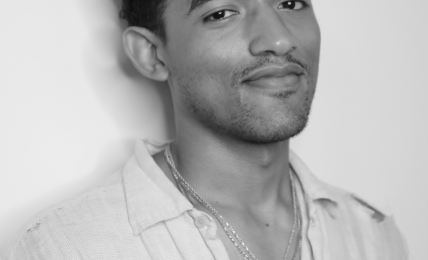Digital America interviewed Chun Guo in November of 2024 on her work Edit Ver. 1.
:::
Digital America: Edit Ver. 1 (2024) is a visually tumultuous adventure that takes us through a full story arc in minutes. The conversations between humans and non-humans within the funhouse make me think about the potential for AI to analyze and mimic human behavior. Can you talk about how you’re playing with identity in this piece?
Chun Guo: This adventure tells the story of how a human, influenced by artificial intelligence, seeks to enhance, disrupt, and reimagine her identity. The inspiration comes from my own experiences, as well as those of my interviewees, and the exploration of technology and identity in cyberpunk fiction. I view identity as a constantly flowing, editable process, one that is dynamic, gamified, and open to exploration. Throughout the journey, the main character undergoes multiple iterations of herself, guided and influenced by non-humanoid figures, which blur her sense of self. The shifts in perspective in the piece hint at the disintegration of the character’s internal perception and the externalization of her identity. These narratives aim to provoke reflection on the alienation and transformation that might result from technology’s deepening intervention in our subjectivity.
DigA: The human voice is gradually lost by the lure of fancy stores and the constant “try me” siren song, reminding me of the always-on algorithms pushing consumerism. How does consumerism and capitalism play a part in the evolution of the characters throughout the piece?
CG: In this piece, consumerism creates a realm filled with mental pollution, where the character’s evolution unfolds within a space of constant “attempts” and “choices.” The “stores” and “shop assistants” within this space symbolize the automated agents of capital and technology, constantly refreshing within the main character’s mental world. The call to “try me” represents the perpetual logic driven by algorithms. As the character’s identity gradually aligns with the standards defined by algorithms and capital, it reflects how consumerism transforms individuals into commodities, reshaping these commodities as extensions of the self. Through this work, I seek to reveal how capitalism, through technology, erodes individual subjectivity, while also illustrating how, within this process of “acquisition,” certain more fundamental aspects quietly slip away.
DigA: You talk about “mental pollution” within your artist statement—this new normal of our digital existence. How does mental pollution play out within the piece? Can you talk about how you approached the overwhelm?
CG: In my work, mental pollution is a metaphor for the contemporary digital environment, representing an invisible force that gradually seeps into human consciousness. During the creative process, I integrated a collection of my own images with AI technology, resulting in distorted and warped images—fragments of my pixels mixed with those of others. These images deviate from my true self, presenting an inhuman, familiar-yet-strange, mechanized AI aesthetic. I transformed the subjects of these images into characters, incorporating them into my work, and used a sweet yet dark dream core aesthetic to materialize the concept of mental pollution as a narrative space that intertwines visual and emotional elements.
DigA: AI has been around for decades, but we are seeing a craze around new tools that make it easily accessible. How have you approached AI in your work? How do you approach the ethics of generative AI?
CG: AI plays the role of a collaborator. Especially when exploring the theme of mental pollution, I realized I needed AI to participate in my process for some interesting experiments. This led to the issue of privacy and data usage. I chose generative AI tools that offer more transparent and understandable decision-making processes, using my own dataset to train models. I didn’t want my identity to be fully recognized, so I applied an “over-editing” approach to the data, which acted as a step towards anonymizing and encrypting it, aligning with the concept of the project. During the training process, generative AI often produced identifiable errors—biased, humorous, illusory, or with a typical AI aesthetic, even leading to the uncanny valley effect. These automated outputs provided valuable insights into my complex interaction with machines. I believe that a creator’s sense of responsibility and boundaries is crucial when facing the ethical questions around AI, especially in a time when AI can influence our identity and creativity.
DigA: How do you approach the difference between your work being shown in browsers (like in Digital America) and in broader festivals/live spaces?
CG: Browsers provide a personalized digital environment controlled by algorithms, which serves as the key entry point for the mental pollution mechanism discussed in my work. It’s interesting to present critical works as digital archives in browsers, where viewers, through their clicks and browsing, complete a cycle: they are both the audience and participants, potentially amplifying the mental pollution unconsciously. In festival or live exhibition spaces, the work is often presented at a larger scale, inviting bodily participation and sensory immersion, fostering deeper connections, especially when exploring complex themes like identity and mental pollution. This interaction adds a face-to-face social dimension, where viewers’ understanding and experience of the work may differ based on their interactions with others.
DigA: What are you working on now? Are there any new forms of expression you hope to explore?
CG: Recently, I’ve been working on turning the pollutant characters and scenes from Edit Ver. I (2024) into AR filters, with my friends being the first “test subjects” of the mental pollution experience. I hope to create more engaging experiences for viewers through these filters, and perhaps one day, this project could develop into a Mixed Reality game.
:::
Check out Chun Guo’s work Edit Ver.1.
:::

Chun Guo is an interdisciplinary digital artist working primarily in critical narrative video and interactive installation. Influenced by artificial intelligence and cyber literature, she uses new technologies to explore relationships between humans and non-humans. She received her MA in Digital Direction from the Royal College of Art. She has shown work at Outernet London, Dreamy Place Festival, and IKLECTIK. Her works invite audiences to explore the intersection of identity across digital, physical, and mental spaces.


